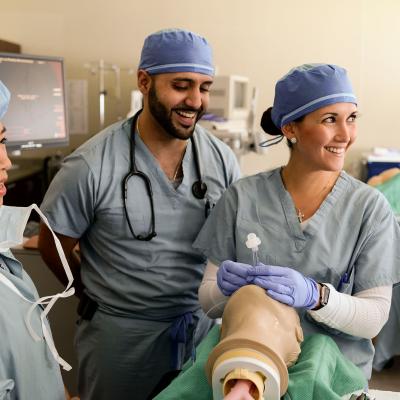- AdventHealth University

While ultrasound technology offers many benefits, sonographers must take precautions to reduce occupational injury. [1] For more than two decades, sonographers have safely used this technology, which is considered safer than radiation. However, as more sonographers enter the profession, health safety advocates raise concerns regarding work-related injury. In response to these concerns, the American Society of Echocardiography (ASE) outlines the following suggestions.
Minimizing Radiation Exposure Risks
Sonographers can receive radiation exposure from patients and equipment during transesophageal echocardiography-assisted fluoroscopically guided procedures (TEEFPs). These procedures may utilize ultrasound and x-ray in fast succession. [2] During the exams, ultrasound professionals work in close proximity to “hot patients,” a term used by medical professionals to describe individuals injected with active radioactive isotopes, or radioisotopes. The close proximity and length of the procedure places sonographers at risk for radiation exposure with increased risk in new sonographers who may take longer to perform tasks.
In the past, hot patients have presented minimal exposure risk. During the last decade, however, the number of TEEFP procedures has increased dramatically. Sonographers may work in hybrid suites designed specifically to conduct TEEFP diagnostics for heart defects, implants, and repairs, further increasing the possibility of radiation exposure.
Radiation exposure can increase the risk for cataracts, leukemia and other forms of cancer. Therefore, sonographers who work in these environments should understand how to protect themselves and minimize exposure. Due to established guidelines, nurse practitioners and x-ray technologists are monitored to ensure radiation exposure is acceptable and minimal. However, researchers have yet to study sonographer exposure in this current practice environment.
Best Practices for Personal Protection
Sonographers should understand how to minimize exposure to radiation in order to reduce the biologic affects. One way to decrease risk, is to increase their proximity to the patient. Sonographers can also reduce the risk of exposure by increasing the time between the patient’s injection and the ultrasound examination, which gives radioisotopes time to decay, or become inactive; however, this may not always be practical or possible.
Sonographers limit radiation exposure by using personal protective devices (PPDs), which include garments and equipment which contain lead or other composites that serve as barriers to radiation such as:
- Eyewear
- Neck collars
- Pregnancy aprons
- Skirts
- Transparent mobile or stationary panes
- Vests
Avoiding direct radiation exposure is key. When it is necessary for the sonographer to be in the radiation field protective garments should be used, and if their hand or hands are in the radiation field, protective gloves or radiation shielding lotion should be worn.
Reducing Musculoskeletal Discomfort and Injury
Awkward and fixed postures while scanning can lead to musculoskeletal injury. [3] The National Institute for Occupational Safety and Health (NIOSH) reports musculoskeletal injuries that develop over time account for a third of all work-related disorders. Sonographers who apply sustained pressure on the transducer for prolonged periods of time are at risk for work-related musculoskeletal injury (WRMSI).
There are specific injuries identified in sonographers due to awkward postures and placement of the equipment. Twisting of the neck and reaching across the bed to scan can put stress on the back, neck, and the arm, particularly the shoulder. Sustained pressure and reaching can lead to pain and injury of the hand, elbow, and shoulder. Sonographers performing a large number of abdominal ultrasound examinations frequently report strain on the shoulder and hand. Adjusting ultrasound equipment, chair, and patient bed can minimize the awkward postures that can lead to WRMSI, but other factors are not as easy to address, including the patient size and work load. The height, age, and gender of the sonographer can also play a role in risk for injury.
The design of the transducers can affect gripping technique and pressure. A transducer with an ergonomic design that promotes a light grip is preferred; and sonographers can benefit from alternating their scanning hand throughout the day.
Ergonomics and Sonography
NIOSH publishes guidelines to reduce physical stressors, such as limiting the time spent in a single position, varying work posture throughout the day, exercising, and maintaining natural wrist and body positions.
NIOSH recommends ample space for equipment, patients, and key personnel. Using a motorized table, can aid sonographers in maintaining optimal ergonomic positionsNarrow examinationallowsonographers to work in close proximity to the patient without excessively reaching and putting stress on their shoulders throughout the day.
Other factors that can reduce injury including varying the types of scans and limiting the number of portable examinations.
NIOSH recommends
- High-resolution monitors to reduce eye strain
- Interlaced displays that scan information from the top down
- Easily adjustable brightness controls
- Positioning the scanning arm so there is a 90-degree angle at the elbow with the arm placed close to the body with limited outward movement (abduction)
- Adjustable footrests and chairs with locking casters
- Ultrasound machines with a moveable keyboard and monitor that can be adjusted independently
Sonographers have unique scanning challenges which can cause WRMSI. Education in ergonomics and application of sound practices can promote a long-term, fulfilling career.
Learn More
The goal of the online Bachelor of Science degree in Diagnostic Medical Sonography (BSDMS) at Adventist University Health Sciences is to prepare sonographers who show a high level of competence and professionalism for future leadership roles, continuing and advanced education, and technology innovations. A sound decision to invest in your future today can lead to an even higher level of career satisfaction tomorrow.
Sources:
[1] https://www.fda.gov/Radiation-EmittingProducts/RadiationEmittingProductsandProcedures/MedicalImaging/ucm115357.htm#industry
[2] http://asecho.org/wordpress/wp-content/uploads/2014/07/2014_RadiationSafety.pdf
[3] https://www.cdc.gov/niosh/docs/wp-solutions/2006-148/pdfs/2006-148.pdf


